
RIVER ENGINEERING
As the consequences of extensive interventions in river systems over the past centuries become increasingly evident, the use of river landscapes and hydropower continues to grow, presenting significant challenges for river engineering. A holistic approach to the water and sediment cycle, both in river engineering and river restoration, as well as the optimization of river engineering measures to fulfill and maintain multiple functions, is more necessary than ever.
River engineering structures interact with flow dynamics, morphology, and, on a larger scale, the entire water and sediment cycle. The consequences of the one-sided objectives of past river engineering measures are becoming increasingly apparent worldwide. The accelerated transport of sediments in straightened and confined rivers is further exacerbated by the growing retention of sediments, for example, through the expansion of hydropower. This leads to a variety of problems. Ecologically, habitat loss for plants and animals occurs when sediment bars disappear due to morphological changes or floodplains dry out as groundwater levels drop due to riverbed erosion. Technically, human infrastructure can be affected, such as when riverbed incision destabilizes bridge piers or reinforced banks, alters the effectiveness of hydraulic structures like groynes, or limits groundwater availability for agriculture and drinking water.
IWA contributes to innovative river engineering and optimized solutions to preserve or restore the diverse functions of rivers for both humans and nature. To address these challenges, IWA employs various methods to gain insights into morphological changes and the current state of rivers, providing a foundation for problem-solving, process understanding, and success monitoring.
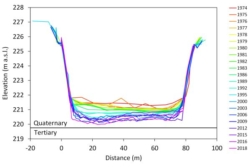
Morphological River Development
Imbalances between sediment input and output lead to changes in the average riverbed elevation, which can cause long-term technical and ecological problems and limit the functions of rivers for humans and nature. IWA uses survey data and sediment transport data to create sediment budgets, assess the morphological condition of rivers, trace potential problems to their causes, and derive solutions. Numerical models and laboratory experiments are also employed to complement these efforts.
River Restoration
River restoration requires allowing morphodynamic processes to occur, which presents new challenges for the planning, implementation, and maintenance of river engineering measures and demands improved predictability of these processes. Tools derived from in-house research are used for this purpose. For example, laboratory model experiments are conducted to determine the width and sediment requirements of river corridors. The optimization of restoration measures considers expected ecosystem services, such as flood protection, as well as ecohydraulic and morphodynamic requirements for habitat provision.
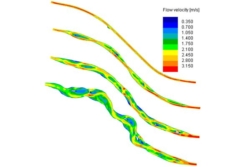
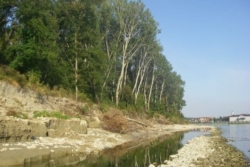
Innovative River Engineering Measures – Longitudinal Structures
Longitudinal structures, such as bank reinforcements and guiding structures, are used to confine parts of the river channel or to manage flood events through controlled discharge, such as levees. However, increasing conflicts of use and the adverse effects of past river engineering measures necessitate innovative solutions that fulfill multiple functions. These measures must remain predictable in their effects, even as they incorporate enhanced morphodynamic processes and vegetation.
IWA supports integrative river engineering projects, where regulatory structures are modified to optimize their regulating effects while simultaneously restoring natural morphodynamic processes. For this purpose, IWA conducts measurements of bank erodibility and develops both user-friendly tools and more complex multidimensional numerical models capable of simulating lateral morphodynamic processes.
Innovative River Engineering Measures – Transverse Structures
In confined spaces, transverse structures can serve to control energy dissipation and reduce sediment transport capacity. The design of such structures must account for both the disruption of sediment continuity and the need for fish passage. IWA conducts research on optimizing various innovative designs, such as the “pendulum ramp” and the “rough ramp,” which aim to minimize impacts on river continuity.
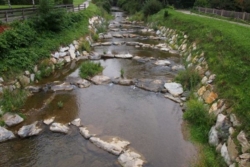
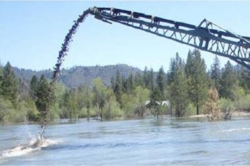
Innovative River Engineering Measures – Sediment Augmentation
When sediment continuity cannot be restored or sediment cannot be naturally supplied, artificial sediment augmentation may be necessary to maintain or restore riverbed levels or habitat-relevant structures. Ship-based sediment augmentation is only feasible during navigable flow conditions and may not always suffice. In such cases, alternative methods, such as sediment depot placements or conveyor belt systems, may be required.
IWA investigates these sediment augmentation methods through field experiments, laboratory studies, and numerical modeling to ensure their effective application in practice. In addition to studying sediment transport away from the augmentation site, the dispersion of sediment is also of interest. IWA continuously advances process understanding in this area through extensive expertise and formulas derived from field and laboratory experiments.